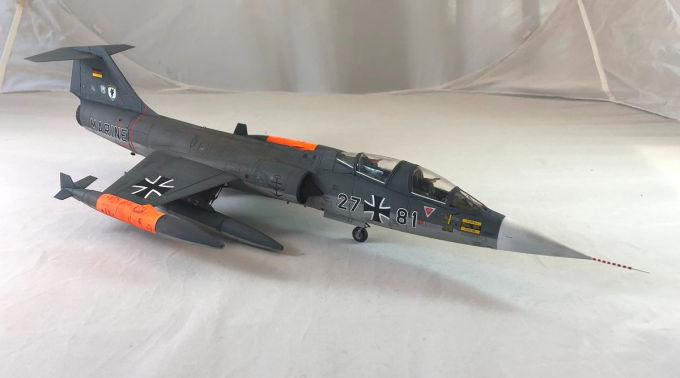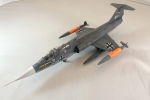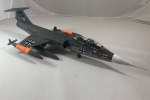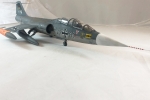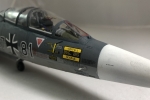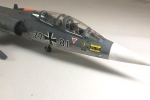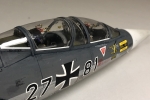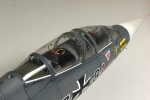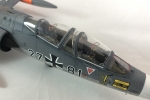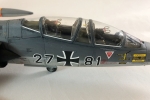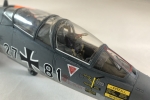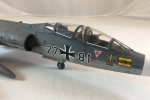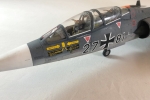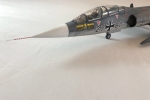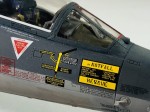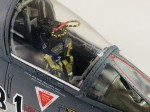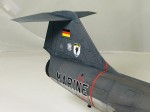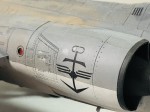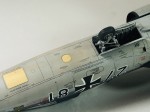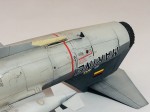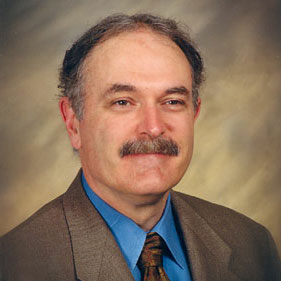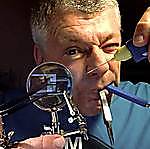1⁄32Double Widow-Maker
Yet the postwar Luftwaffe also had the worst experience with crashing and dead pilots associated with the F-104 airframe: 116 pilots killed in 269 accidents. Nasty nicknames attached themselves to the F-104G like tin cans tied to a stray dog's tail by cruel boys: Witwemacher ("widow-maker") and Fliegender Sarg ("flying coffin") or even the highly visual "tent peg." The cause of the high rate of crashes is still debated: lousy weather over much of Germany (pilots were initially trained to fly in the clear, dry air of Texas)? Human error by inexperienced pilots and/or conscript maintenance personnel? Or the Luftwaffe's decision to switch a pure interceptor to a low-flying fighter-bomber role?
Whatever the reason, the German air force flew 36% of all Starfighters from 1961-1987, so it's no wonder modelers have been drawn to the F-104G. Italeri released the single-seat version, then followed with the (T)F-104 G two-seat trainer. As a companion to my in-box review of the kit, I agreed to build it out-of-the-box (more or less).
The build is pretty straightforward, with a clear instruction booklet and easy-to-follow sub-assemblies handled more or less logically. The only issues are fit (it's an Italeri kit), and some poorly-realized components. The wingtip and underwing fuel tanks have bad seams, and will require some careful filling and sanding, especially as the filler caps are right on the seams, yet must be glued from the inside at the time the tank halves are assembled. The fuselage has only one tricky fit issue: two PE "rings" that set off the rear portion and the stabilizer fin that simply don't mesh well. I dropped it out and the parts went together without a hitch (you can't see the internal support frame they're supposed to recreate unless the engine is removed).
I resisted my usual inclination to add every bit of after-market stuff around, and only replaced three items: the exhaust nozzle (undersized and has oversimplified details), swapped for the Eduard resin one from the early, American-supplied GE J79 engine with scooped-out blade ends. The kit's Martin Baker ejection seats are undersized, again with simplified details. So I replaced them with two AMS resin versions. That saved wrangling with photo etch seat belts and other rigamarole. Finally, I added a Master Models pitot tube for the front, since part of it was bare metal on the actual aircraft.
Otherwise I pretty much used the kit parts. The decals were a bit of a composite: many of the stencils are from the nice Cartograf-printed sheet supplied with the kit, but a number were taken from Danny Coremans' DACO Products complete F-104G set. The five sheets perfectly compliment his superb reference work on the G variant, and are ample enough I'll be able to use remainder of the set on the single-seat F-104G I'm working on.
For paints other than black or white, I used Hataka's Bundesluftwaffe colors. German naval jets in the 1960s used a two-tone scheme of white aluminum undersides and basalt gray topsides. The basalt gray is very close to WW2 Panzer Gray, but I wanted to be as accurate as possible. The Hataka paints are very airbrush-friendly, but they are not quick-drying, so all the pre-shading I did on the underside got lost when the white aluminum color "settled." I recommend applying multiple light coats and letting each one dry thoroughly (something I don't have to do with Vallejo paints, for example).
The decal instruction booklet has camouflage schemes for all the different German F-104 variants, as well as unit badges, "zappings" (temporary markings popular with Luftwaffe units), and fuselage codes for every singular regular unit. But it also has the alternate naval colors and markings, so I chose a set from an actual aircraft that flew with MFG1 (Marineflieger Geschwader 1. The unit was active from 1959-1993, flew 132,000 hours in F-104Gs, and lost eleven pilots to fatal accidents. The eagle in the unit coat of arms was borrowed from the WW2 Luftwaffe unit Kampfgeschwader 30, likely because KG30 had extensive naval engagements on several fronts.
My decision to build the aircraft with the canopies closed arose from my struggle attempting to wrestle a build of the single-seat version into shape. That build sports all the AM stuff I could find, and after much cutting, sanding, filling and filing (none of which has yet produced an end point), I just wanted to keep things clean and easy.
It's a decision I don't regret.




